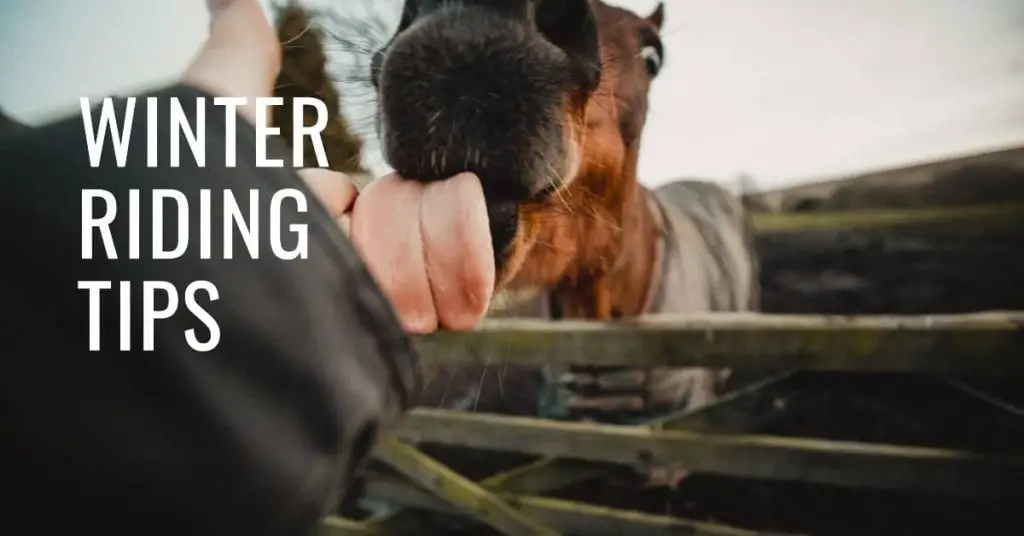How cold is too cold to ride a horse? Generally, horses can tolerate temperatures as low as 0°F (-18°C). That being said, the conditions of the air and ground should also be taken into consideration. If it is too windy, icy or snowy outside, then riding a horse would likely be unsafe.
In addition to considering the temperature and conditions, you should also think about how well your particular horse is adapted to cold weather. Cold-blooded breeds, such as drafts, are better suited for colder climates, while warm-blooded breeds may become uncomfortable in lower temps. Ultimately, it depends on all these factors combined when determining if it is too cold to ride a horse.
Riding a horse in cold weather can be exhilarating, but it’s important to remember that extreme temperatures can be dangerous for the rider and their equine companion.
Riding in winter should only be done if the temperature is above freezing and preferably when there is no wind chill. Even then, riders should ensure they are warmly dressed with layers of breathable clothing to protect them from the elements.
If you’re ever unsure how cold is too cold for riding, it’s best to err on caution and wait until conditions improve.
Ensuring Your Horse’s Health in Cold Weather
When riding horses in cold temperatures, it is vital to monitor their health and comfort. Look for signs of distress like shivering, slowed reactions, or lack of appetite.
Check the horse’s ears, muzzle, and legs for coldness. After riding, thoroughly dry the horse’s coat, brush it out, and offer hot mashes or warm bran to help them recover from the cold exposure. If you have concerns about the horse’s ability to handle the low temperatures, consult an equine veterinarian.
Regular health assessments are essential for safely riding horses when the weather is very cold.

Protecting Yourself as a Rider in Frigid Temperatures
Riding horses in freezing conditions can be just as uncomfortable for you as for the horse. Dress yourself in multiple insulating layers to retain body heat.
Wear breathable base layers, sweaters, coats, snow pants or other garments to stay warm. Protect your extremities with thick socks, gloves, scarves and hats. Wear a neck warmer to shield your nose and mouth from the icy air.
Stay hydrated and avoid prolonged exposure to the frigid elements. After riding, go indoors quickly and change out of any damp clothing to prevent chilling. Take precautions to avoid frostbite or hypothermia when braving the cold temperatures.
Is 30 Degrees Too Cold to Ride a Horse?
When riding a horse in cold temperatures, there is no single answer. Many riders and equine professionals will tell you that 30 degrees is too cold for general riding conditions, as the risk of hypothermia increases at this temperature.
Additionally, horses may suffer discomfort due to the chill in their muscles and joint stiffness, leading to an increased risk of injury while under saddle.
If you choose to ride in colder weather, be sure your horse has been adequately groomed beforehand with a thick winter blanket if necessary and opt for shorter rides until both horse and rider become acclimated to the temperature drop.
It’s also important to consider wind chill factors when deciding on whether or not it’s safe enough for your horse; even if it isn’t technically below freezing outside with wind gusts factored in, temperatures can feel much colder than they are, so take extra caution when planning your ride times during winter months.
Knowing When to Stop Riding
While horses and their riders can adapt to the cold to some degree, there comes a point when extremely frigid temperatures pose excessive risks. If the cold becomes hazardous or highly uncomfortable for you or your horse, even with preparations, it is best to avoid riding.
No single ride or training session merits jeopardizing the health and safety of you and your equine partner. Wait for slightly warmer days, or consider doing groundwork with the horse in a covered arena instead. Listen to your instincts and the horse’s signals about when conditions become intolerable. Don’t be afraid to stop riding for the sake of wellbeing.
Is 45 Degrees Too Cold to Ride a Horse?
The answer to the question “Is 45 degrees too cold to ride a horse?” depends on several factors, including the physical condition of the horse and rider. Generally speaking, temperatures from 40-60 degrees Fahrenheit (4-15 Celsius) are ideal for riding horses outdoors. At temperatures below this range, cold weather may cause discomfort for both horse and rider due to chill winds or freezing rain.
Moreover, colder temperatures can increase the risk of injury by making hooves more brittle than normal. Therefore, it is best that riders avoid taking their horses out when temperatures drop below 40 degrees Fahrenheit (4 Celsius).
In any case, if you do decide to take your horse out in 45-degree weather, then make sure that you have warm clothing and blankets available, as well as appropriate footwear so that neither you nor your horse will suffer from hypothermia or frostbite in such conditions.
Can You Ride a Horse in the Winter?
Yes, you can ride a horse in the winter! However, there are some special considerations when riding this time of year. Winter weather can be unpredictable and harsh at times, so it is important to make sure your horse is equipped with proper winter gear, such as blankets or sheets for protection from the cold and windy conditions.
Additionally, it is best to keep your rides short due to the colder temperatures and shorter daylight hours. Make sure your horse’s hooves remain healthy by using appropriate hoof care products like hoof boots if they will be walking on icy surfaces or salted roads. Lastly, always have an emergency plan in place should something go wrong while out riding – such as having someone else nearby who knows what you are doing just in case something happens.
With these precautions, you can enjoy riding even during the chilliest months of the year!
How Do I Know If My Horse Is Too Cold?
When determining if your horse is too cold, there are a few signs you should look out for. You can begin by running your hand along the length of their body and feeling for any chill in their fur. If they feel cold to the touch, then they may be suffering from hypothermia or low body temperature due to exposure to cold weather conditions.
Other signs that indicate your horse may be too cold include shivering, lethargy, decreased appetite and difficulty with movement due to stiffness in joints caused by extreme temperatures.
Additionally, horses left outside during winter months without adequate shelter are more prone to becoming chilled, as well as those with thin coats or poor health conditions such as old age or illnesses like arthritis.
Which can make them more sensitive than other animals when exposed to colder temperatures.
To keep your horse warm and safe, it’s important that you provide adequate shelter from rain and wind, as well as ensure that hay is always available so they can maintain energy levels throughout the day, even when not grazing on grasses outdoors.
Is It Too Cold To Ride Your Horse?
Conclusion
In conclusion, horse owners should be aware of the temperatures when deciding to ride. If it is too cold for the rider’s comfort, then it is also likely too cold for the horse as well. The best advice is to pay attention to both temperature and wind chill in order to make an informed decision about going out for a ride.
It may be wise to err on the side of caution by not riding if temperatures are below freezing or conditions are extreme.
Janet G Kulick is an experienced horse rider, trainer, and owner of the informative horse blog, Horseray.com. Her engaging writing style and wealth of knowledge on horse care, riding, and training make her a trusted source for horse enthusiasts worldwide.






